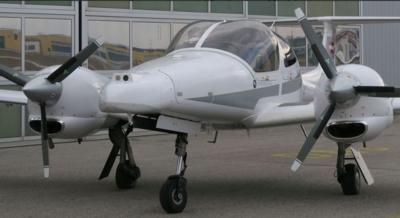Thu, Nov 17, 2016
System Should Improve Safety For Both Manned And Unmanned Flights
In close cooperation, experts of the AIT Austrian Institute of Technology and Diamond Aircraft Industries GmbH, have developed an intelligent sensor system enabling aircraft to detect and avoid potential obstacles both in the air and on the ground. This innovative airborne assistance system is an important step towards improving the safety of manned and unmanned flight.

Collision avoidance systems are a key technology for future unmanned aerial systems and advanced air traffic services. The objective is to increase the safety of manned and future unmanned aviation by detecting possible collisions with both cooperative and non-cooperative obstacles, and performing avoidance maneuvers as a last resort to avoid collisions. Obstacle avoidance is the key technology in missions involving the highest possible degree of autonomy, e.g. for generating situation maps for crisis and disaster management.
Experts at AIT have taken an innovative vision-based approach, enabling future unmanned aerial systems to observe and understand their environment in real-time. This approach goes beyond the state-of-the-art, making use of novel sensing techniques and route planning strategies for collision avoidance. The technology is capable of detecting both cooperative and non-cooperative objects in the airspace by fusing passive electro-optical and thermal-infrared sensor data. The technology was integrated in a Diamond Aircraft DA42 MPP and demonstrated in relevant scenarios.

Diamond Aircraft has used the test results to assess potential applications for this technology as an innovative and effective safety-improving feature both for unmanned flying objects and manned aviation. One option would be to integrate the technology into an autonomous flight control system similar to the one developed during a recent Diamond Aircraft project which, in 2015, successfully demonstrated safe autonomous flying for manned aircraft in emergency situations, including completely automated landing. Another possible use could be sensorial integration into conventional manned aircraft, to increase situational awareness and prevent collisions with airborne or ground obstacles. This would offer an additional and more reliable pair of artificial “eyes” able to generate potentially life-saving collision avoidance advisories.
(Images provided with Diamond Aircraft news release)
More News
Minimum Friction Level The friction level specified in AC 150/5320-12, Measurement, Construction, and Maintenance of Skid Resistant Airport Pavement Surfaces, that represents the m>[...]
Aero Linx: Airpower Museum The APM owns 30 acres on Antique Airfield, including the south half of the N-S runway. It consists of three hangars, an annex, and a library. The museum >[...]
Patient Told The First Responders That The “Man Who Was In The Plane Was Flying At The Time Of The Accident And Had Overshot The Runway They Were Attempting To Land On.&rdquo>[...]
Klyde Just Can't Believe This Has Gotten To This Point... FMI: www.klydemorris.com>[...]
Also: Duffy Wants $$$, KS Airports, Morningside U’s Aviation School, New Airstrip In ID After 6 were killed in a helicopter crash over the Hudson River, several US Representa>[...]
 ANN's Daily Aero-Term (06.02.25): Minimum Friction Level
ANN's Daily Aero-Term (06.02.25): Minimum Friction Level ANN's Daily Aero-Linx (06.02.25)
ANN's Daily Aero-Linx (06.02.25) NTSB Prelim: Champion 7ECA
NTSB Prelim: Champion 7ECA Classic Klyde Morris (From 06.10.22)
Classic Klyde Morris (From 06.10.22) Airborne 05.30.25: Anti-Helicopter Bill, PW Strike Done, All-Electric Bristell
Airborne 05.30.25: Anti-Helicopter Bill, PW Strike Done, All-Electric Bristell




